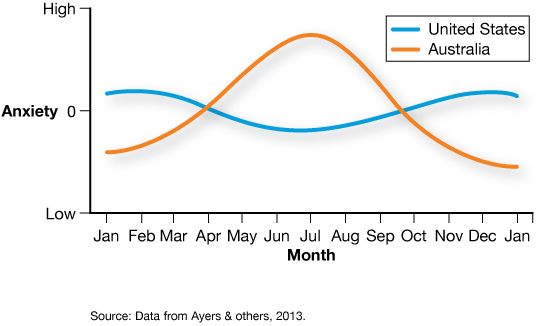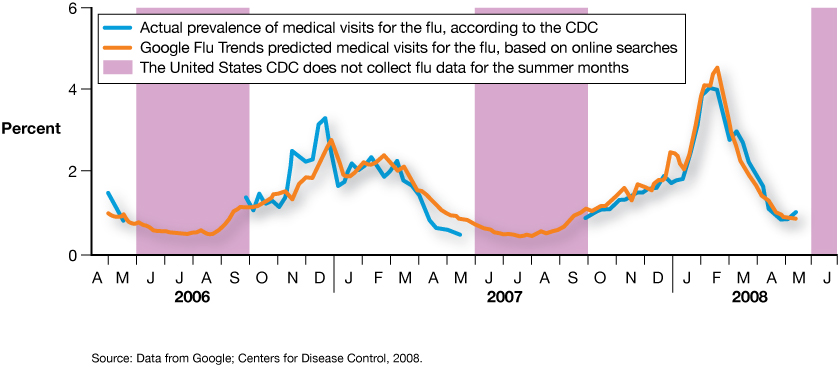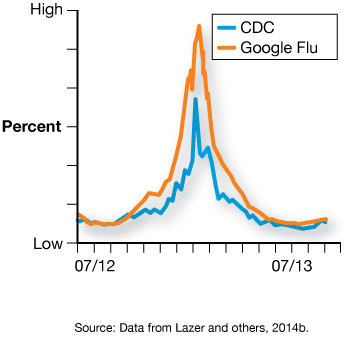Chapter 14. Tracking Mental Illness Online
14.1 Welcome
Think Like a Scientist
Tracking Mental Illness Online
By:
Susan A. Nolan, Seton Hall University
Sandra E. Hockenbury
REFERENCES
Ayers, John W.; Althouse, Benjamin M.; Allem, Jon-Patrick; Rosenquist, J. Niels; & Ford, Daniel E. (2013). Seasonality in seeking mental health information on Google. American Journal of Preventive Medicine, 44, 520-525.
Centers for Disease Control and Prevention. (2015). Behavioral risk factor surveillance system. Retrieved from http://www.cdc.gov/brfss/
Helft, Miguel. (November 11, 2008). Google uses searches to track flu’s spread. New York Times. Retrieved from http://www.nytimes.com/2008/11/12/technology/internet/12flu.html
Lazer, David; Kennedy, Ryan; King, Gary; & Vespignani, Alessandro. (2014a). The parable of Google Flu: Traps in big data analysis. Science, 343, 1203-1205. Retrieved from http://gking.harvard.edu/files/gking/files/0314policyforumff.pdf
Lazer, David; Kennedy, Ryan; King, Gary; & Vespignani, Alessandro. (2014b). Google Flu Trends still appears sick: An evaluation of the 2013-2014 flu season. Available at SSRN: http://ssrn.com/abstract=2408560, http://dx.doi.org/10.2139/ssrn.2408560 or http://gking.harvard.edu/files/gking/files/ssrn-id2408560_2.pdf
Lohr, Steve. (March 28, 2014). Google Flu Trends: The limits of big data. New York Times. Retrieved from http://bits.blogs.nytimes.com/2014/03/28/google-flu-trends-the-limits-of-big-data/
FAQ
What is Think Like a Scientist?
Think Like a Scientist is a digital activity designed to help you develop your scientific thinking skills. Each activity places you in a different, real-world scenario, asking you to think critically about a specific claim.
Can instructors track your progress in Think Like a Scientist?
Scores from the five-question assessments at the end of each activity can be reported to your instructor. To ensure your privacy while participating in non-assessment features, which can include pseudoscientific quizzes or games, no other student response is saved or reported.
How is Think Like a Scientist aligned with the APA Guidelines 2.0?
The American Psychological Association’s “Guidelines for the Undergraduate Psychology Major” provides a set of learning goals for students. Think Like a Scientist addresses several of these goals, although it is specifically designed to develop skills from APA Goal 2: Scientific Inquiry and Critical Thinking. “Tracking Mental Illness Online” covers many outcomes, including:
- Interpret, design, and conduct basic psychological research: Describe research methods used by psychologists including their respective advantages and disadvantages [compare telephone surveys versus online searches as methods of collecting data]
- Demonstrate psychology information literacy: Interpret simple graphs and statistical findings [understand online search data presented in graphs]
14.2 Introduction
This activity invites you to test the claim that we can track patterns of mental illness, like anxiety disorders, by analyzing online searches. First, you’ll conduct a search to explore what comes up when you Google “anxiety.” Then, you’ll look at evidence from a study that analyzed online searches to track patterns in mental illness. Next, you’ll explore alternative explanations for these findings based on your own online searches. Finally, you’ll examine internet search data—a type of “big data”—as a source of information about mental health patterns.
14.3 Identify the Claim
1
Identify the Claim
14.3.1 Tracking Mental Illness
Is depression more common in the winter? Are eating disorders more frequent in some countries than in others? Does anxiety spike around the holidays? Researchers often want to explore patterns related to the frequency of mental illness in the population. Unfortunately, many of the most common research techniques are flawed. Researchers can’t use treatment records because most people with a mental illness never get treated. Telephone surveys are often used, but they are expensive to conduct. There’s also the question about how people respond to telephone questions about their mental health. Would you tell a researcher your mental health history over the telephone?

14.3.2 Take a Survey About Health Problems
One of the largest and longest-running telephone surveys is the Behavioral Risk Factor Surveillance System, run by the U.S. Centers for Disease Control (CDC). Participants are asked about different types of health problems, including mental health, physical health, and exposure to environmental hazards like mold. Click whether you would feel comfortable (or not) admitting to dealing with the issue mentioned in each of these questions from an interviewer.
QUESTIONS FROM THE BEHAVIORAL RISK FACTOR SURVEILLANCE SYSTEM SURVEY |
I’D ADMIT TO THIS. |
I’D NEVER ADMIT TO THIS. |
“Have you ever been told by a doctor, nurse, or other health professional that you have high blood pressure?” |
YES |
NO |
“During the past 12 months, have you had an episode of asthma or an asthma attack?” |
YES |
NO |
“During the past 30 days, about how often did you feel so depressed that nothing could cheer you up?” |
YES |
NO |
“About how often during the past 30 days did you feel nervous — … all of the time, most of the time, some of the time, a little of the time, or none of the time?” |
YES |
NO |
“Do you currently have mold in your home on an area greater than the size of a dollar bill?” |
YES |
NO |
“Has your household air been tested for the presence of radon gas?” |
YES |
NO |
“Since 2005, have you had a tetanus shot?” |
YES |
NO |
“During what month and year did you receive your most recent flu shot injected into your arm or flu vaccine that was sprayed in your nose?” |
YES |
NO |
14.3.3 Online Searches and Mental Illness
Can Google read your mind? Increasingly, researchers analyze what is known as “big data,” enormous amounts of computerized information. Some researchers speculate that our online search history, a treasure trove of big data, can provide a window into our thinking, behavior, and experiences. Could this be true for tracking mental health? If yes, then researchers could track patterns of mental illness by analyzing online searches. For example, an increased number of searches for bipolar disorder, anxiety, or depression could indicate higher occurrence rates for those mental illnesses. Researchers think we might Google “depression” even if we aren’t willing to tell a close friend we are suffering from the mental illness.

Question 14.1
G17OtfAJPEzIJxYQx9/m2ZAXJ3UwErYS6yNNLl3Q8e6E9MQhybGfWHDkuf3Cr9rkzC2IDEYFJN8lUuAZTi3L1J8OfCyxfhe7N0nqDAy0U0y2DSJD5oTzXqWN3nclD3HeEt3ngSJ9X5quVeUY5iilwRHDmWPD3I+GeWR1q3j96GMQCeDdN9cFV3VwS980erx987oKMZYMqhS/K4xCt8ShIQgAupa7QtsGGxw3J5r8VIoPKXxtXmcyCNqKTqUg2g1Hjf0pLMxXmb/i9M+3BEn7jROTCYSZSqCbYXwTDGCS/XrgjdwvcuqK+bApgLNGX9iZx1/jnEdaE1TLVWyrTxQUJnTmFBGXikzV0K2/G6JYX3Tkk45HclTFQSoCakO5p6pHS3xwlrv2PO7cj5KmuQAGlx+vgdDqgqHcw60tufBg2Bb57zE3X2vdOkWoZ+EeANPv1oX2MUz3IcpdLAJc89g2NCb58qoBHqFZoAfAlzVFRapnKwxUPx76DAtueh8r1Vocr8XYFie5QMTxkJmYHCPlMf+95hZVC/nQ97VZOEC3iuR4uEvU5seWbMVA2B2WUuWdmAioaauKiL6o6yeU6hpxTjqr0kxMyqkWOSlV4lPzrwo9TmzyOhsS1wUz5zD2jQgULaUpDoEt0VmzcrndkZS1WEjJrMn12sejjZK6EikePIkN1tzvqyjBgiP95tEtr27X8Q9gfyYw8faFRg5NO5Kqq+mbm1giRUjcBynamM1zWSueHjs+oIl4RzgdAwYB6r3ANWwD9mL7QM6kUT0NzWe3Bx7BZd4mQm4zFOcv7jgfdyeKa69w2JVWZXzelNEAAgN5GK7m3mR3aYmwdoKaHi1Gn4EUdZAbfRsUUPx6sW0JCPpVtAspJs2IWsmuVyp45ucwZpo0s1PkC6AHSudqNdA85V228uqW9Ae12rJm8A==14.4 Evaluate the Evidence
2
Evaluate the Evidence
14.4.1 Testing the Claim
The claim that Google search frequencies mirror the frequencies of mental illness in the population has already been examined. Based on previous studies, researchers believed that searches for mental illness occurred when someone developed a disorder for the first time, had a recurrence of that disorder, or found their symptoms getting worse (Ayers & others, 2013). So, they analyzed all Google searches in the United States and Australia to determine the frequencies of the following search terms:
| |
These researchers were particularly interested in whether mental illness is more common in the winter or in the summer.


14.4.2 Summer vs. Winter
The researchers wanted to use Google to explore whether certain mental illnesses occur more in the summer or the winter. For all the mental illnesses they studied—depression, anxiety, schizophrenia, and so on—the researchers found increased searches in the winter and decreased searches in the summer. Even more interesting is that these findings couldn’t be attributed to something going on in the world—like a war, a drought, or a natural disaster—because the seasons in the United States and Australia are opposite of one another. And based on the months of the year, the U.S. and Australian results were completely opposite of each other. As you can see in the graph here, U.S. searches peaked when Australian searches were at their lowest. (Note that the tick marks on the graph represent 6-month intervals. The tick marks above the years are for January and those in between are for July.) Because summer in the United States occurs during the Australian winter, and winter in the United States coincides with the Australian summer—which turned out to be a very cool way for the researchers to replicate their own research.

Question 14.2
1dhmdSLmAitLX+7CG00sOHV/IUZtOHFWfFFAFxvPl+9jDe4b6YNjzPgJ37uvy0zbEM/XGqEqQ17s8p7be7rL7pxzTgGTMMPrHRzRakhdi/bmInQmNvXjQP25/3GaCPA2B6VL9aElZonaec0vEhhyY6rzinO3E9wrzM0D+NwxmpqGCiqAmFAMv89gAwTVA5DvPFX4Hs+ZylH491PGnbCXb3UBGWglfupg0cBu8BKwfvEYh5kgBDvM/xMDeqOtNSsNNGlXxA==14.5 Consider Alternative Explanations
3
Consider Alternative Explanations
14.5.1 What Do Google Searches Really Measure?
Do Google searches actually measure patterns of mental illness? Or is there an alternative explanation for these findings? The researchers think that Google searches are accurate measures of how common these disorders are in the population (Ayers & others, 2013). Their research methods eliminated some of the problems with other types of research, including people’s reluctance to answer questions truthfully, such as in a telephone survey. Their research methods also avoid the possibility of prompting a specific answer just by asking about mental illness. When asked about depression, for example, you think about depression, and you might report symptoms you hadn’t thought about otherwise. In an internet search, however, you provide information about a mental illness without being asked. So a Google search shows your natural behavior rather than your prompted behavior or your behavior in the laboratory.
Take a look at the graph below. In the United States (blue), anxiety is highest in January and December (winter in the northern hemisphere) at each end of the graph. In Australia (orange), anxiety is highest in June, July, and August (winter in the southern hemisphere) in the middle of the graph.

14.5.2 Googling Anxiety
But what does it really mean when you Google a mental illness? Can an online search engine know you’re anxious? Let’s explore alternative explanations for what online searches really indicate. Open another browser window or tab on your computer, and search for “anxiety” using a search engine. As you scroll through the first several pages of results, note the different types of Web sites. Then come back here and click off each of type of Web site you found. We’ll come back to your answers in the next screen.
Question
| ZycNTMvpRoSnXPUZl8FiVl5s+iDEL2Bo | Information about anxiety disorders (definition, symptoms, treatment) |
| ZycNTMvpRoSnXPUZl8FiVl5s+iDEL2Bo | Organizations like hospitals or research centers that treat or research anxiety |
| ZycNTMvpRoSnXPUZl8FiVl5s+iDEL2Bo | News stories about anxiety |
| ZycNTMvpRoSnXPUZl8FiVl5s+iDEL2Bo | Anxiety tests, quizzes, or screening tools |
| ZycNTMvpRoSnXPUZl8FiVl5s+iDEL2Bo | Listservs or forums related to anxiety |
| ZycNTMvpRoSnXPUZl8FiVl5s+iDEL2Bo | Information on anxiety in animals |
| ZycNTMvpRoSnXPUZl8FiVl5s+iDEL2Bo | Things that seem unrelated to anxiety disorders but have “anxiety” in their names, such as a book, film, or song |
| ZycNTMvpRoSnXPUZl8FiVl5s+iDEL2Bo | Other: |
14.5.3 What Are We Really Searching For?
On the previous screen, you reported the types of Web sites you found from an online search for “anxiety.” Were all of the sites about anxiety disorders? [] It’s possible that people searching for “anxiety” are not referring to anxiety disorders in people. Maybe they just have an anxious dog. Similarly, people searching for “depression” might mean an economic depression, something that tends to pop up toward the top of online searches.

14.5.4 Who Is Conducting the Search?
As we just observed, it’s possible that some people who Google words like “anxiety” and “depression” are searching for something other than mental illnesses. But realistically, this probably only reflects a small proportion of searches. As you saw when you Googled “anxiety,” most of the results gave us information about anxiety disorders—definitions, symptoms, treatment, and other useful information. But what about the person doing the searching? A person who has symptoms of a mental illness may be searching to get more information. Who else might search? List three reasons that someone might search for a mental illness like anxiety, depression, or schizophrenia.
Reason 1:
Reason 2:
Reason 3:
14.6 Consider the Source of the Research or Claim
4
Consider the Source of the Research or Claim
14.6.1 Google Searches as a Source of Data: The Case of the Flu
The source of the data for tracking mental illness online was Google searches. So how good are Google searches as sources of data? To find out, let’s look at Google Flu Trends, a tool that reportedly could “detect regional outbreaks of the flu a week to 10 days before they are reported by the Centers for Disease Control and Prevention” (Helft, 2008). We know the flu numbers that Google Flu Trends predicted and the actual flu data from the CDC, so comparing them will tell us how well Google predicts an illness other than mental illness. With searches for mental illness, we have predictions, but not the actual numbers.

14.6.2 Google Flu Trends vs. the CDC
A few years back, the media excitedly reported the success of Google Flu Trends (Helft, 2008). Based on these data, Google created maps that showed where the flu was spreading earlier than was ever before possible, which allowed for earlier public health efforts that helped to reduce flu outbreaks.
The graph below shows estimates for the number of people with the flu based on Google searches, and the actual number of people with the flu that was eventually reported by the CDC. (Note that the initials on the x-axis refer to months. For example, A=April.) So, at first glance, it seems that Google searches are good predictors for the flu, and might be for mental illness, too.

Question 14.3
qH19tkS0h6rh6d24uVZcgRMWWjDIUo9gMcMf8WK6s2fPFdsai9tAEu6nX4GP5rvH8c/VXO53aFvrJ7Fl2fQ1Cxq0ebjOCzPapog94SWBgGZXdaLyNYm5DnT/LmdBqmFBOAUEsYR1zi0eIR5yeRsXOWBqF/zxiRmLbOxvPxMa4WkXpqppgTd/8ZJDLh1owLAoFnqRmxHkLfRWU/AL6GyBz6UJ3bR3FeITUPbH9f2a0tviTFn8xQp8vz+6qE1c5X2E4TLaPNjJhZ2juJL7kvAkpz4bwryFnSahjD6ppZIQ6wdzmIhfVezXpz3O7F9KzCvldZyGZEMX8wQ3M5CI6kEtR6mSjhwKXbJB93cuFgjBY01QkESHVpGW7P+if610cE3XMhCWMRg6QO4eYKetKrbbgcmU88GMWyqmuc5v4a4TuxOsmA17hh5WpbHT5ce0d1v3v7zzo4vgZ+wLSAZBacL7ed+H+aANtvD9/94ZUBHdBWY8FoevmVeYcYLhpx7dt6cPa46EMXzCf0cHplbBzS4+wxxHFvArpR726eMTnv71lK/W9UJmBgzvDfTg+Y2MbfZWVLsBwRncJIbyAQFzHBw/Wgy+9fwl3dHpPwnYNUDft0vtsfU8AYP508h9gxr4uw5sK8iz/Kcg/z28KgoXRz07GnxDUQ8Mj41bIqpT3GOC8VAJ97+CSmwGB5zYvuo43jMEp9/hclavijaGZOgWIiOzWAjSx5UhIu6dAxh4bcw6Y58QxAiJ/7C06PK17bumJClbdy9iXLDcK6jky+simOwLZVs4hxNIrG16cldsotsxxGHz3HTfRCdm4sC2s5FWLEODC9a9QiG/PmLVpu33luw/Q6ssvas=14.6.3 The Drawbacks of Google Flu Trends
Despite optimistic early results, it turns out Google Flu Trends was overhyped, an indication that we should be cautious with other types of online searches—such as those for mental illnesses. Researchers reported that Google Flu Trends predictions were routinely higher than the actual numbers reported later by the CDC—and substantially higher in 2012–2013 (Lazer & others, 2014a). They suggested one possible reason: Google’s model might have caused increased flu searches. Try it yourself. Open a new page or tab, and Google symptoms associated with the flu, like “fever” or “cough.” Pay attention to how many results on the first page mention the flu. Return here when you’re done.
Question
jbbntAnui8YOb6ONS8iHwJBZso9yfQhyers2vYzw+5Gt3uCSV+zrE8LjEFtOczaLGEGoxHp/1u02fOfnfvoGLXOaTrWHzHHG4+cB9bOFgQWVMfWx5g/0baTPRwQZ9ZQEzHqyLos2NdCCl0DbwnnkmLLchDVMCy8GqWcC6ya127WoJVkQsa9ELS882RrefjXeDHp3SB/yAUXnoLDHPD3lhQ==14.6.4 Google Flu Trend Overestimates Outbreaks
Seeing results like these might make you more likely to search for additional information on the flu, even though you never intended to search for the flu. You may have noticed that a number of illnesses besides the flu came up in your search. You might only have a cold, which is a more likely diagnosis. Or, you might have something worse than the flu—like whooping cough, which is a less likely diagnosis. Google has since tweaked its flu-tracking tool so it works better, but it still overestimates the flu by about 30% (Lazer & others, 2014b). Some of the same kinds of problems might be occurring with searches for mental illness, although we don’t yet have data (like the CDC’s data on flu) to evaluate these searches.

14.6.5 Harnessing Big Data: A Compromise
Even though Google Flu Trends overestimates the number of people with the flu, it’s not completely off. Moreover, combining it with the CDC data leads to better predictions than either on its own. As one researcher pointed out, “the mash-up is the way to go” (Lohr, 2014). Researchers have also observed that more traditional methods, like survey research, can be improved by using methods from big data analyses, like increased use of the internet to conduct research (Lazer & others, 2014a). Their idea is to analyze data from both “traditional and new sources,” which provides “a deeper, clearer understanding of our world.” Other researchers can learn from this advice as they improve the tracking of mental illness. Early indicators from Google Flu Trends indicate that online searches—whether of physical illness or mental illnesses—might be useful predictors, particularly if they’re used along with other sources of information.

14.7 Assessment
Assessment